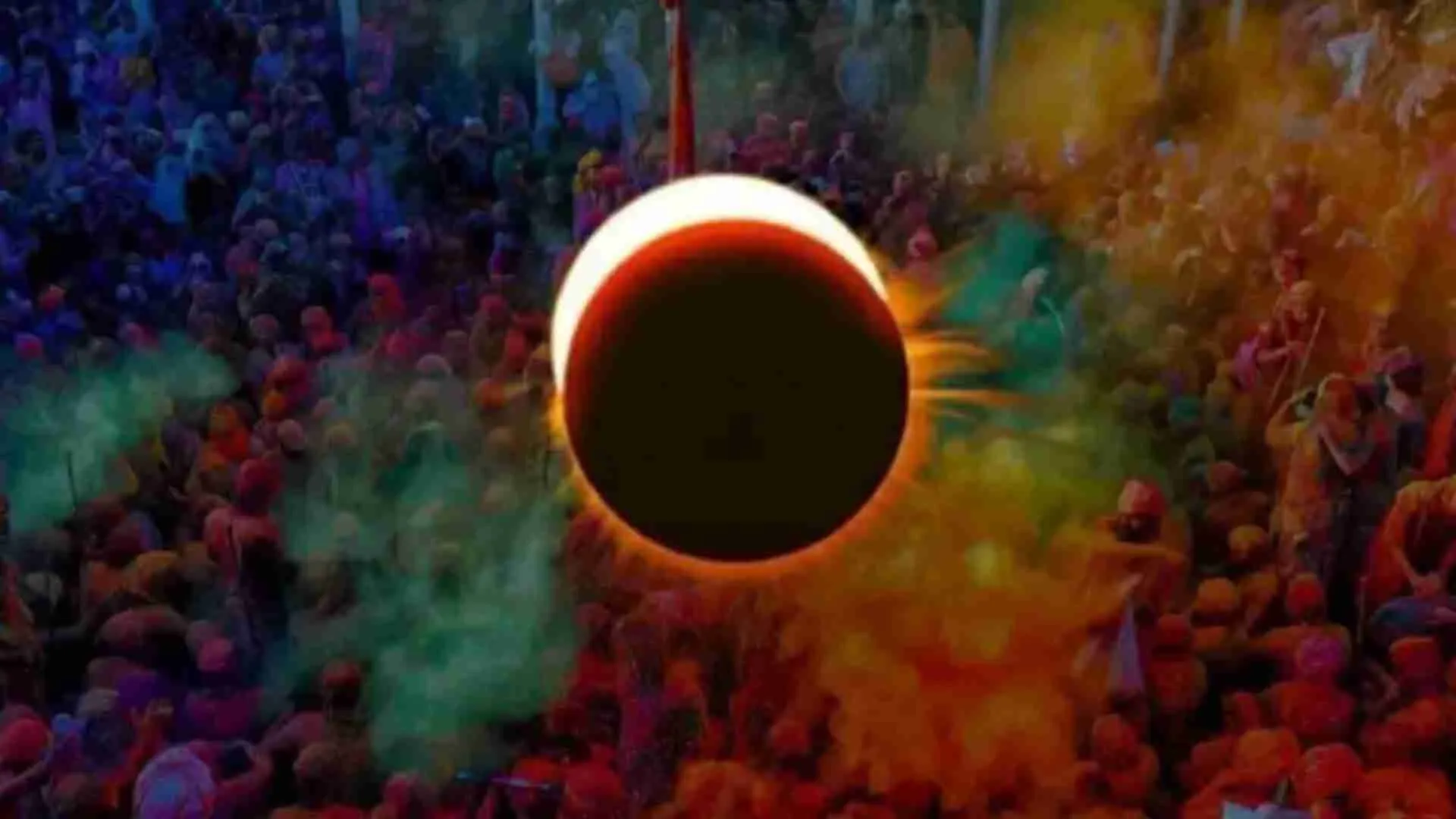The Vedic literature points out that God is both personal and impersonal. God’s impersonal aspect is called different names by different people. Generally, the impersonal aspect is known as the Brahman effulgence or brahmajyoti. A description of the Brahman can be found in various portions of the Vedic literature, including the Mundaka Upanishad (2.2.10-12) where it says: “In the spiritual realm, beyond the material covering, is the unlimited Brahman effulgence, which is free from material contamination. That effulgent white light is understood by transcendentalists to be the light of all lights. In that realm there is no need of sunshine, moonshine, fire or electricity for illumination. Indeed, whatever illumination appears in the material world is only a reflection of that supreme illumination. That Brahman is in front and in back, in the north, south, east and west, and also overhead and below. In other words, that supreme Brahman effulgence spreads throughout both the material and spiritual skies.”
To realize or attain entrance into the impersonal Brahman, one must practice yoga for many years without falling down from such strict practice. One must be celibate, chant the om mantra correctly, raise the life airs within the body to the top of the head, and leave the body while meditating on the Brahman. If one cannot void his mind of all sensual engagement and concentrate on the Brahman for hours at a time without agitation, one will not be successful. If one is successful, one can be liberated from material existence by merging into the Brahman, where there is eternity and knowledge. However, there is no real ananda or bliss there. The only pleasure in the brahmajyoti is the freedom from all material suffering. Some yogis think such pleasure, which may be felt on elementary levels of meditation, is a sign of reaching the final goal. But real ananda is found only in spiritual engagement. Without understanding this, one’s spiritual knowledge is incomplete.
The goal of the impersonalists is to merge into the Brahman effulgence, where they lose all of their individual characteristics. If they succeed, they remain there as an inactive spiritual spark, floating in the rays of the brahmajyoti. They do not develop a spiritual body that would give them the opportunity to engage in various spiritual activities because they do not know about such engagement that can be found on the spiritual Vaikuntha planets that exist within the Brahman effulgence. So, if they again have any yearning for engaging in activities, they cannot go upward to the spiritual planets because they are not qualified to do so. Thus, they are forced to seek shelter in the material world, where they start over again.
The problem is that it is our natural inclination to be active, always doing something. So if the soul is so active while within the material body, how can the impersonalist philosophers suggest that once we are liberated we will be completely inactive? This is not very logical. The Vedic literature states that once one has attained liberation and reaches the brahmajyoti, he will not stay there, but at some point he will again desire to return to the material world for engagement. Therefore, the brahmajyoti is not considered the highest form of spiritual liberation, although some so-called sages today speak of it as if it is.
Such impersonalist yogis or philosophers either do not know or simply reject the fact that beyond nirvana and the outskirts of the Brahman effulgence are the Vaikuntha planets of the spiritual sky. Thus, due to their ignorance, or even rebelliousness against God, they concentrate only on the impersonal Brahman. One can enter that region by the difficult, mechanical yoga process for controlling the mind, but cannot go any higher. Just as a person cannot escape the material world if he still has material desires, he cannot enter the spiritual planets if he is still absorbed in thinking of the void. In this way, such people are unable to enter into the spiritual life of complete eternity, knowledge, and bliss. Therefore, the idea of achieving spiritual liberation by merging into the Brahman effulgence is considered the process of a cheating religion. Why it is considered this is that it destroys the opportunity for people to reestablish their loving relationship with the Supreme. This is confirmed in the Caitanya-caritamrita (Adi.1.92): “The foremost process of cheating is to desire to achieve liberation by merging in the Supreme, for this causes the permanent disappearance of loving service to Krishna.” Therefore, those who have reached mature spiritual realization look upon merging into the Brahman effulgence as a great mistake.
The impersonal realization of the Brahman effulgence is the indirect process of understanding the Absolute Truth and is considered a difficult path according to Bhagavad-gita. “But those who fully worship the unmanifested, that which lies beyond the perception of the senses, the all-pervading, inconceivable, fixed and immovable–the impersonal conception of the Absolute Truth–by controlling the various senses and being equally disposed toward everyone, such persons, engaged in the welfare of all, at last achieve Me. For those whose minds are attached to the unmanifested, impersonal feature of the supreme advancement is very troublesome. To make progress in that discipline is always difficult for those who are embodied.” (Bg.12.3-5)
By realizing this impersonal Brahman, one only realizes the bodily effulgence of the Absolute. In other words, the all-pervading spiritual force has a source. This is clearly described in the Caitanya-caritamrita, (Adi.2, 5 & 15):
“What the Upanishads describe as the impersonal Brahman is but the effulgence of His body, and the Lord known as the Supersoul is but His localized plenary portion. He is the Supreme Personality of Godhead, Krishna Himself, full with six opulences. He is the Absolute Truth, and no other truth is greater than or equal to Him. The opulence’s of the impersonal Brahman spread throughout the millions and millions of universes. That Brahman is but the bodily effulgence of Govinda [another name of Krishna].”
The fifteenth and sixteenth mantras of the Isa Upanishad also acknowledge that from the personal body of God comes the rays of the Brahman effulgence: “O my Lord, sustainer of all that lives, Your real face is covered by Your dazzling effulgence. Please remove that covering and exhibit yourself to your pure devotee. O my Lord, O primeval philosopher, maintainer of the universe, O regulating principle, destination of the pure devotees, well-wisher of the progenitors of mankind–please remove the effulgence of Your transcendental rays so that I can see Your form of bliss. You are the eternal Supreme Personality of Godhead, like unto the sun, as am I.”
From these verses it is clear that without going beyond the Brahman effulgence, one cannot see the real form of the Supreme. If one reaches the stage of realizing the Brahman and becomes convinced that he has attained the Ultimate, then he does not have complete understanding or full realization. He still must go further until he has reached the source of the Brahman, which, according to the Isa Upanishad, is the Supreme Personality.
Since the Brahman effulgence is considered to be but one of the opulences of the Supreme, it should be understood that whenever the Vedic texts speak of Brahman, they are indicating the Supreme Personality of God. In fact, it is stated that in the Vedic literature the word Brahman means, “in whom all the attributes reach to the infinity.” In this way, it is clear that Brahman primarily means the Supreme Person, of whom the Vedic literature is full of descriptions of various aspects of His infinite qualities and characteristics. The Caitanya-caritamrita clearly states: “The word ‘Brahman’ indicates the complete Supreme Personality of Godhead, who is Sri Krishna. That is the verdict of all Vedic literature.” (Cc.Madhya-lila, 6.147)
The Caitanya-caritamrita (Adi.7.112) also explains that, “Everything about the Supreme Personality of Godhead is spiritual, including His body, opulence and paraphernalia.
The Brihadaranyaka Upanishad says, purnam idam purnat purnam udacyate: “Although He expands in many ways, He keeps His original personality. His original spiritual body remains as it is.” Thus, we can understand that God can expand His energies in many ways, but is not affected or diminished in His potency.
The Svetasvatara Upanishad (6.6) also states: “The Supreme Personality of Godhead, the original person, has multifarious energies. He is the origin of material creation, and it is due to Him only that everything changes. He is the protector of religion and annihilator of all sinful activities. He is the master of all opulences.” This verse specifically points out that only due to God’s multi-potencies does the world continue to change and be maintained. He also protects religion, which could not be done if He were impersonal. This is only logical since it takes a person to watch over, protect, or maintain anything.
In the Katha Upanishad (2.2.13), there is the important verse nityo nityanam cetanas cetananam eko bahunam yo vidadhati kaman: “He is the supreme eternally conscious person who maintains all other living entities.” From these descriptions in the Vedic texts, we can clearly understand that God is the Supreme Person who is the source of everything and controller of all. This Supreme Person is the Absolute Truth, as confirmed in the Caitanya-caritamrita (Adi.7.111): “According to direct understanding, the Absolute Truth is the Supreme Personality of Godhead, who has all spiritual opulences. No one can be equal to or greater than Him.”
Since it is established in the Vedic texts that the Absolute is a person, then meditating on the personal form of God rather than the impersonal feature is the highest form of meditation. This is verified in Bhagavad-gita (12.2): “The Supreme Personality of Godhead said: ‘He whose mind is fixed on my personal form, always engaged in worshiping me with great and transcendental faith, is considered by me to be the most perfect.’”
Herein, we can understand that realizing the absolute truth in the form of the Supreme Person is much easier and much more attractive than struggling to merge into the great white light of the brahmajyoti. By understanding the Supreme Personality, all other aspects of the Absolute, such as the Brahman effulgence and Paramatma or Supersoul, are also understood. In fact, those who are absorbed in Brahman realization can easily become attracted to understanding the Supreme personality as did such sages as Sukadeva Gosvami and the Kumaras as noted in Srimad-Bhagavatam
Gaurangasundar das is IskconInc Communication Director and SM IT head























